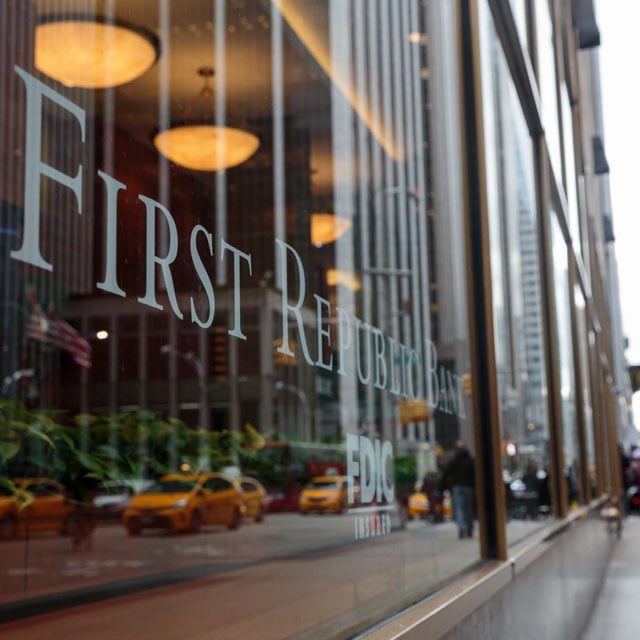First Republic's Wealth Unit Goes From Wall Street Raider to Prey in Days

Just days ago, First Republic Bank boasted of another coup for its wealth-management business: poaching a six-person team from Morgan Stanley in Los Angeles.
That followed hiring sprees targeting Bank of America Corp., JPMorgan Chase & Co., Bank of New York Mellon Corp. and Wells Fargo & Co. — raiding crews in Boston, New York and Palo Alto, California. It reflected how the San Francisco-based bank was rapidly expanding on the back of tech riches.
Now First Republic is racing to reassure customers and clients that it can avoid the fate of Silicon Valley Bank, which collapsed last week after its depositors fled.
First Republic’s stock plunged 28% on Thursday and is down about 80% since March 8.
It’s exploring strategic options including a sale, and is expected to draw interest from larger rivals. JPMorgan and Morgan Stanley are among those discussing a potential deal with the bank that could include a sizable capital infusion, the Wall Street Journal reported Thursday.
It’s a stunning turn of events for the lender, which built up a wealth-management franchise with some $271 billion in assets, putting it in rarefied air among American institutions. Yet it’s the emphasis on that business that could make First Republic’s fate different from SVB and New York’s Signature Bank.
While it expanded rapidly into capital call lines of credit and lending to venture capitalists — services in which SVB specialized — its specialty serving the affluent is seen as making it more attractive than its California counterpart.
“First Republic Bank grew up in wealth,” whereas “SVB started in portfolio companies,” said Joe Maxwell, managing partner at Fintop Capital, a fintech venture capital firm. Even though there’s a lot of overlap, where they started is still “part of their DNA,” he said.
A representative for First Republic didn’t immediately reply to a request for comment. Emails sent to the leaders of its newly added adviser team weren’t immediately returned.
In a March 12 message to clients, signed by Executive Chairman Jim Herbert and Chief Executive Officer Michael Roffler, the bank said it has taken steps to bolster its liquidity with access to additional financing from JPMorgan.
“For almost 40 years, we have operated a simple, straightforward business model centered on taking extraordinary care of our clients. We have successfully navigated various macroeconomic and interest rate environments,” they said.
Different Origins
First Republic’s origin story, in many ways, couldn’t be more different than SVB’s.
Herbert founded First Republic in 1985, based on a hunch that jumbo home mortgages to wealthy, established Californians was too good a business to pass up. SVB’s model of providing banking to startups was conceived a few years prior — over a poker game.
Yet in the coming four decades, as interest rates tumbled and hot tech money came to dominate American finance, their customer bases began to overlap.
First Republic started actively courting Silicon Valley’s tech wealth. The bank opened a branch inside Facebook’s campus in Menlo Park, California, in an effort to win over early employees on the road to riches. In San Francisco, it has a bank location inside Twitter’s headquarters on Market Street, which remains open.
Meanwhile, SVB’s offerings grew as founders and venture capitalists got rich, with the firm eventually buying wealth manager Boston Private in 2021.
Still, that wealth business pales in comparison to First Republic’s, which saw assets balloon to $271 billion from just $17.8 billion at the end of 2010.
Major Player
It was around that time that First Republic executives initiated a plan to transform its wealth division into a major player. Among its first deals was buying Luminous Capital, with $6 billion in client assets, for a reported $125 million in 2014.
“They weren’t penetrating the high-net-worth investment business very well” back then, said Luminous co-founder David Hou.
As assets continued to climb, eventually surpassing $100 billion, Hou and Mark Sear, his partner, opted to split from the bank. They left in 2019 to start Evoke Advisors.
Hou, Sear and other Evoke partners though have kept money with First Republic amid the past week’s upheaval. So have other clients and fund managers, some expressing love for the bank on social media and urging people to stay put.
One Silicon Valley investor said they planned to keep all of their personal and business funds with First Republic.
Despite not having its origins in tech, the investor, who asked not to be identified discussing private information, found First Republic better understood the complexities of private tech wealth than the big banks — and on an even footing with SVB.







